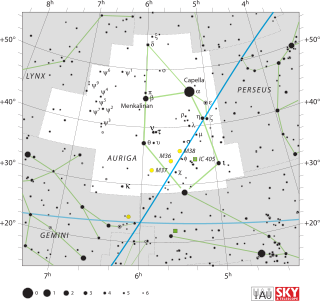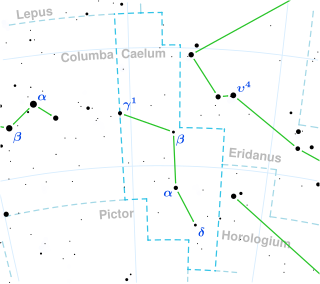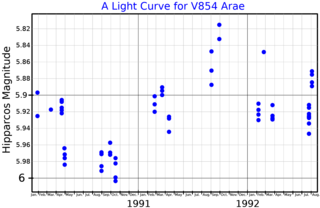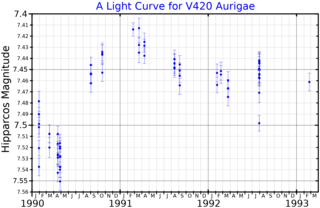
Chi Aurigae, Latinized from χ Aurigae, is the Bayer designation for a binary star system in the northern constellation of Auriga. It is visible to the naked eye with an apparent visual magnitude of 4.74. The distance of Chi Aurigae is determined at 3,900 ly based on spectroscopic observations. Parallax measurements by the Hipparcos spacecraft were unsuccessful because the parallax error was bigger than the value itself, while the Gaia spacecraft measured the parallax with a 22% error, giving a distance of 3590±750 ly. The brightness of the star is diminished by 1.26 in magnitude from extinction caused by intervening gas and dust.

13 Andromedae, abbreviated 13 And, is a single, blue-white hued variable star in the northern constellation of Andromeda. 13 Andromedae is the Flamsteed designation, while it bears the variable star designation V388 Andromedae. With a typical apparent visual magnitude of around 5.75, it is dimly visible to the naked eye under good seeing conditions. The distance to this star can be directly estimated from its annual parallax shift of 10.9 mas, yielding a range of 300 light years. At that distance, its brightness is diminished by an extinction of 0.13 magnitude due to interstellar dust. The star is moving closer to the Earth with a heliocentric radial velocity of −8 km/s.

9 Aurigae is a star system in Auriga (constellation). It has an apparent magnitude of about 5, making it visible to the naked eye in many suburban skies. Parallax estimates made by the Hipparcos spacecraft put it at about 86 light-years from the solar system, although individual Gaia Data Release 3 parallaxes place all three components at 88 light years.

AE Aurigae is a runaway star in the constellation Auriga; it lights the Flaming Star Nebula.

AR Aurigae, also known by its Flamsteed designation 17 Aurigae, is a binary star in the constellation Auriga. Based on parallax measurements made by the Hipparcos spacecraft, it is approximately 461 light-years from Earth.

Kappa Cassiopeiae is a star in the constellation Cassiopeia.

4 Cassiopeiae is a red giant in the northern constellation of Cassiopeia, located approximately 790 light-years away from the Sun. It is visible to the naked eye as a faint, red-hued star with a baseline apparent visual magnitude of 4.96. At the distance of this system, its visual magnitude is diminished by an extinction of 0.56 due to interstellar dust. This system is moving closer to the Earth with a heliocentric radial velocity of −39 km/s.

R Centauri is a Mira variable star in the constellation Centaurus.

RV Caeli, also known as HD 28552, is a solitary, red hued variable star located in the southern constellation Caelum, the chisel. It has an apparent magnitude of 6.4, placing it near the limit for naked eye visibility. The object is located relatively far at a distance of 1,340 light years based on parallax measurements from Gaia DR3, but is rapidly receding with a heliocentric radial velocity of 98 km/s.

V385 Andromedae is a variable star in the constellation Andromeda, about 360 parsecs (1,200 ly) away. It is a red giant over a hundred times larger than the sun. It has an apparent magnitude around 6.4, just about visible to the naked eye in ideal conditions.

HD 155035 is a star in the constellation Ara, the Altar. It is located at a distance of approximately 1,450 light-years from Earth and has an apparent visual magnitude of 5.92, making it is faintly visible to the naked eye. This is a red giant star with a stellar classification of M1.5 III.

PU Aurigae is an irregular variable star located in the constellation Auriga. A red giant, it varies by 0.1 magnitude around magnitude 5.64, so it is faintly visible to the naked eye. Located around 560 light-years distant, it shines with a luminosity approximately 1,523 times that of the Sun and has a surface temperature of 3,482 K.

V420 Aurigae is a high-mass star with an inferred compact companion. Closely orbiting each other every 0.8 days, they are a source of X-ray emission.

HD 32188 is suspected variable star in the northern constellation of Auriga, and is positioned roughly in between Eta and Zeta Aurigae. It has a white hue and is just barely visible to the naked eye with an apparent visual magnitude that fluctuates around 6.08. The distance to this star is approximately 3,000 light years, based on parallax. It has an absolute magnitude of −2.87.

NO Aurigae is a pulsating variable star in the constellation Auriga. It is an unusually-luminous asymptotic giant branch star about 3,500 light years away. It is a 6th magnitude star faintly visible to the naked eye under very good observing conditions.

Phi Herculis is a binary star system in the northern constellation of Hercules. Based upon an annual parallax shift of 15.99 mas as seen from Earth, it is located around 204 light years from the Sun. With a combined apparent visual magnitude of 4.24, it is bright enough to be seen with the naked eye.

V1073 Scorpii is a variable star in the constellation Scorpius. It has a non-Greek Bayer designation of k Scorpii. The star has a blue-white hue and is visible to the naked eye with an apparent visual magnitude that fluctuates around +4.87. Parallax measurements yield a distance estimate of approximately 2,920 ly (896 pc) from the Sun, and it is drifting further away with a radial velocity of +7 km/s. It has an absolute magnitude of −6.8

Y Centauri or Y Cen is a semiregular variable star in the constellation of Centaurus.

V3903 Sagittarii is an eclipsing binary star system in the constellation Sagittiarus. It creates an H II region LBN 29 1,070 parsecs away from the Sun.

SY Equulei, also known as HD 203664, is a single variable star located in the equatorial constellation Equuleus. It has an average apparent magnitude of about 8.5, varying by a few hundredths of a magnitude, making it readily visible in binoculars and small telescopes, but not to the naked eye. The star is relatively far away at a distance of 8,000 light years and is receding with a heliocentric radial velocity of 48 km/s. At that distance, SY Equulei is dimmed by 0.19 magnitudes due to interstellar dust.

















